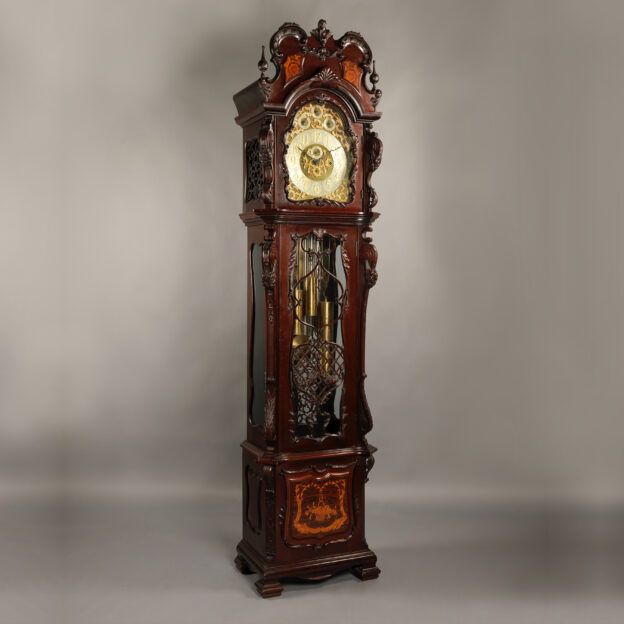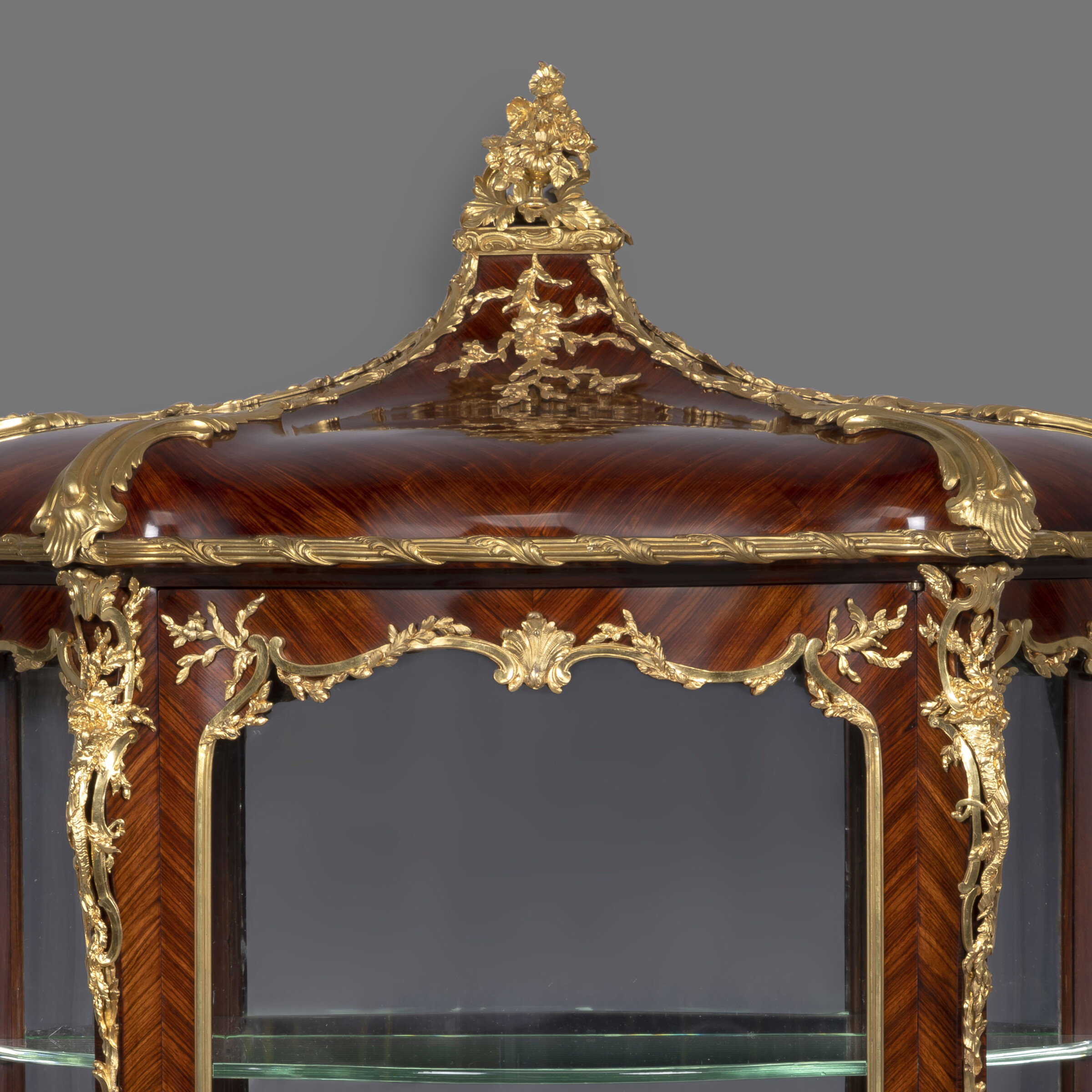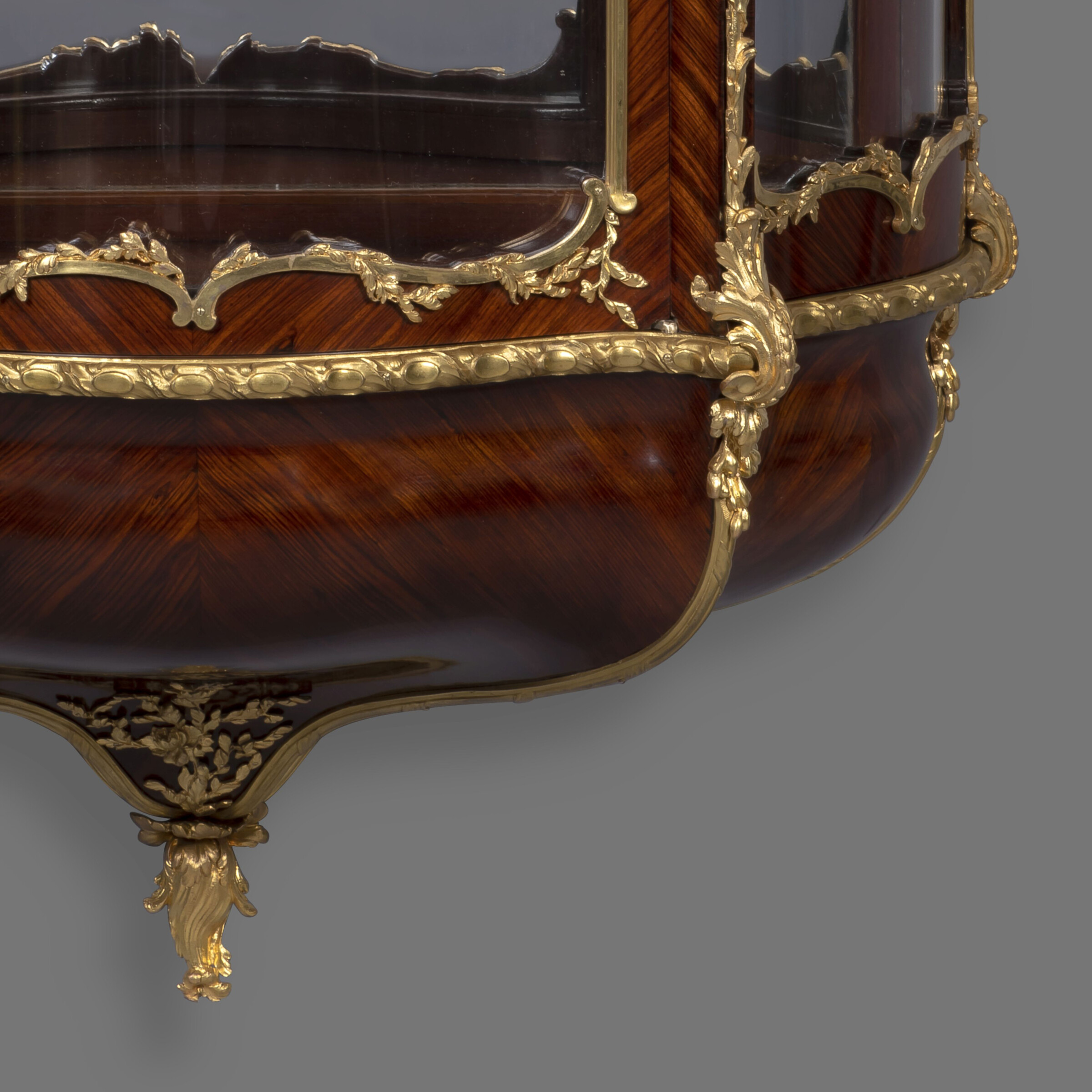Emmanuel Zwiener
An Unusual Louis XVI Style Gilt-Bronze Mounted Wall Vitrine
£38,000
An Unusual Louis XVI Style Gilt-Bronze Mounted Wall Vitrine by Zwiener. The vitrine has a domed top with gilt-bronze acanthus mounts, surmounted by...
尺寸
高度:135厘米(54英寸)Width: 64 cm (26 in)
Depth: 35 cm (14 in)
描述
An Unusual Louis XVI Style Gilt-Bronze Mounted Wall Vitrine by Zwiener.
The vitrine has a domed top with gilt-bronze acanthus mounts, surmounted by an urn issuing flowers. The shaped front and side panels have curved glass and are framed by exceptional gilt-bronze foliate mounts above a bombe shaped apron with a foliate gilt bronze terminal. The interior with a mirrored back and two shelves, on scrolled apron.
法国,约1890年。
日期
约1890年
原产地
法国
中型
Gilt-Bronze and Mahogany
The Zwiener brothers Emmanuel and Julius produced some of the most innovative luxury furniture of the late 19th century. They developed a unique style which blended the florid high rococo of the Louis XV period with contemporary Art Nouveau influences, employing the sculptor Léon Messagé who is credited with creating the naturalistic rococo designs for which Zwiener was awarded a Gold Medal at the 1889 Paris Exposition Universelle. Léon Messagé also designed exhibition pieces for Zwiener’s contemporary, François Linke, and it has been speculated that Linke may have worked for Zwiener when he first arrived in Paris in 1875. Therefore it is unsurprising that there are so many stylistic similarities between the furniture of Zwiener and Linke or that they are the most prized and famous Parisian ébénistes of the Belle Époque.
The most recent research indicates that there were three Zwiener brothers from Herdon, Germany. The eldest brother Joseph had by the 1880s established a substantial workshop in the city of Breslau in Silesia, now in Western Poland. His younger brothers Emmanuel and Julius were, by the same time, working in Paris. Recorded from 1880 with workshops at 12, rue de la Roquette they established themselves as premier haut luxe cabinet makers of the period, producing elegant pieces of furniture replicating royal models from the Garde-Meuble National of France, most notably a replica of the celebrated bureau de Roi by Jean-Henri Riesener and Jean-François Oeben which was supplied to Ludwig II at Herrenchiemsee, which was placed in the King’s study in 1884. Their own creations varied a dynamic interpretation of the French Rococo style. Zwiener’s furniture is often inlaid with the finest marquetry and set with ambitiously modelled ormolu figural mounts. In 1895, on receiving an important royal commission from Kaiser Wilhelm II of Prussia, Julius returned to Berlin to set up his own workshops and the same year his brother Emmanuel retired selling the 12, rue de la Roquette workshops for 10,000 francs to Jean-Henri Jansen (1854-1929), founder of Maison Jansen. Dating from this time, some Zwiener furniture is found to be stamped by both Zwiener and Jansen.
Zwiener’s production culminated in being awarded the coveted medaille d’or for a rococo style vernis Martin-decorated serre-bijoux cabinet at the Paris 1889 Exposition universelle. It subsequently entered the collection at Gatchina of Empress Maria Feodorovna of Russia and was most recently sold in London in 2011. The jury at the 1889 exhibition noted ‘dès ses débuts d’une Exposition universelle, [il] s’est mis au premier rang par la richesse, la hardiesse et le fini de ses meubles incrustis de bronzes et fort habilement marquetis’ (‘from his debut at the exhibition, [Zwiener] has been in the top tier for his furniture of great richness, boldness and finished with bronzes and skilful marquetry’). Many of the pieces executed by Zwiener for the Prussian royal palaces were brought to Huis Doorn in Utrecht in 1918, where the Kaiser lived in exile until his death in 1941, and in addition to making furniture for Kaiser Wilhelm II of Prussia and King Ludwig II of Bavaria, Zwiener supplied furniture to an elite international cliental including some of his most famous pieces for the New York mansion of the financier and art collector Charles Tyson Yerkes (1837–1905). Zwiener furniture is also recorded at De Haar Castle, the Netherlands, probably originally supplied to Etienne and Hélène de Zuylen, née de Rothschild for their Paris home.
The gilt-bronze mounts to furniture by Zwiener were often marked to the reverse with the maker’s initials. Several of Zwiener’s mounts have been found to have a ‘Z’, ‘ Zw’, a ‘IZ’, ‘NZ’, ‘ZN’ or a ‘ZJ’ on the reverse. Few pieces known to be by Zwiener have been found to be stamped or have a full signature and /or a date.
Bibliography:
Mestdagh, Camille & Lécoules, Pierre. L’Ameublement d’art français : 1850-1900, Les Editions de l’Amateur, (Paris), 2010; pp. 301-305.
Payne, Christopher. François Linke, 1855-1946, The Belle Epoque of French Furniture, Antique Collectors’ Club, (Woodbridge, UK), 2003.
Meyer, Jonathan. Great Exhibitions – London, New York, Paris, Philadelphia, 1851-1900, Antique Collectors’ Club, (Woodbridge, UK), 2006; p. 270, pls. H14; p. 299, p.302.
D. Ledoux-Lebard, Les Ébénistes du XIXe Siècle, (Paris), 1984, pp. 645-648.
Maze-Sencier. Les Livres des Collectionneurs, (Paris), 1885.












 印刷品
印刷品


